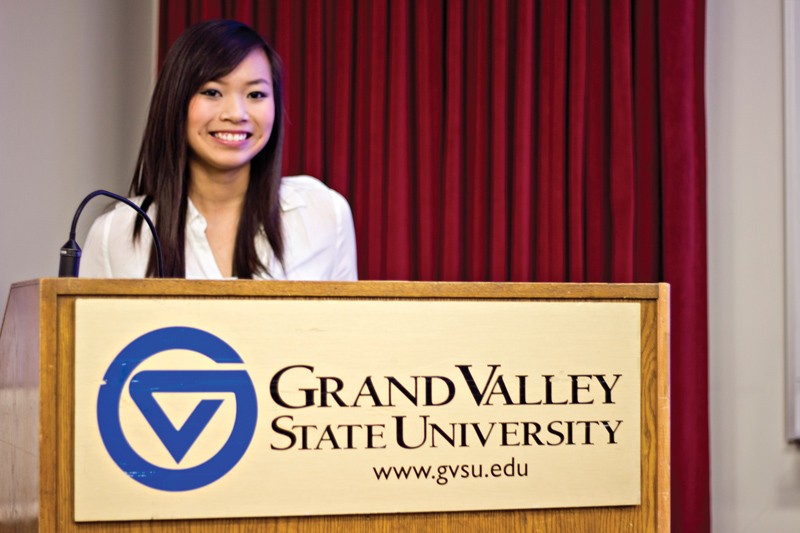Media’s Portrayal of the Asian Culture

GVL / Amanda Greenwood Student Christine Vo during her presentation about Asian Representation in the Media.
Feb 14, 2013
Christine Vo, vice president of the Multicultural Greek Council, offered insight at Tuesday’s Asian Pacific American Heritage Month event about the restrictive media portrayals of Asians in America and the many avenues that are left to be fulfilled by Asian actors and actresses.
As a junior at GVSU with a major in sociology and a minor in women and gender studies, Vo’s coursework and involvement on campus has allowed her to continually work to increase awareness on issues that affect both race and gender. With what Vo recognized as a lack of positive role models in the entertainment industry today, her particular interest in Asian representation evolved.
At the start of her presentation, ‘Asian Representation in the Media,’ Vo promoted awareness by presenting facts about what it means to really be Asian. She said 5.6 percent of the U.S population is considered Asian, which is ultimately composed of 51 different countries.
Despite this significant portion of Asians in the American population, limited and unbalanced portrayals of Asian Americans in the media have been the norm despite the good intentions of many producers and filmmakers, she said. Among these portrayals are a variety of demeaning stereotypes, most of which Vo said were created during World War II, depicting Asians as one body with a single set of characteristics.
“These limited portrayals catalyze a limited understanding of Asians, themselves,” Vo said. “Media portrays Asians as one collective identity, basically, a notion that all Asians look and act alike.”
Specifically referring to Asian females, Vo discussed two dichotomies that are common among a female with Asian heritage: ‘china dolls’ and ‘dragon ladies.’
“China dolls are Asian women looked at as helpless, in need of assistance or rescue and good natured at heart,” Vo said. “Dragon ladies are pretty much the complete opposite and are Asian women seen as sexy, manipulative, with a tendency toward disloyalty and opportunism.”
When specifically looking at the stereotype cast on Asian men, the ‘ruthless villain’ is usually a common role portrayed through Hollywood. Vo pointed out that a very well-known example of this ‘ruthless villain’ is in the movie “The Hangover,” where Ken Jeong plays the role of Mr. Chow.
As a culture, despite gender, media can also go the opposite way and portray Asians as a culture that obtains a higher degree of success than any other culture, acting as the model minority.
“My analysis of this is modern media is starting to use this tactic known as retro-racism, pretty much poking fun at the stereotypes, like we are all in this joke together,” Vo said.
“This begins to be a problem when people don’t see it as a joke, they really do think that these stereotypes are what Asians are in general. Just because we may recognize the joke doesn’t change the fact that media is poking fun of Asian culture.”
With negative stereotypes also comes negative consequences such as questioning individual identity, emotional trauma and social isolation. Yet the Media Action Network for Asian Americans offered solutions to this problem, such as more roles of Asian Americans being cohesive to the rest of society, acting as more positive contributors to society, and holding more lead roles in general.
With this information presented, Vo challenged the audience to get involved with as much as possible and increase awareness.
“I encourage you guys to get involved in as many organizations as possible or just continue to educate yourselves in many other ways,” she said.
For more information about other Asian Pacific American Heritage Month, visit www.gvsu.edu/oma.

























